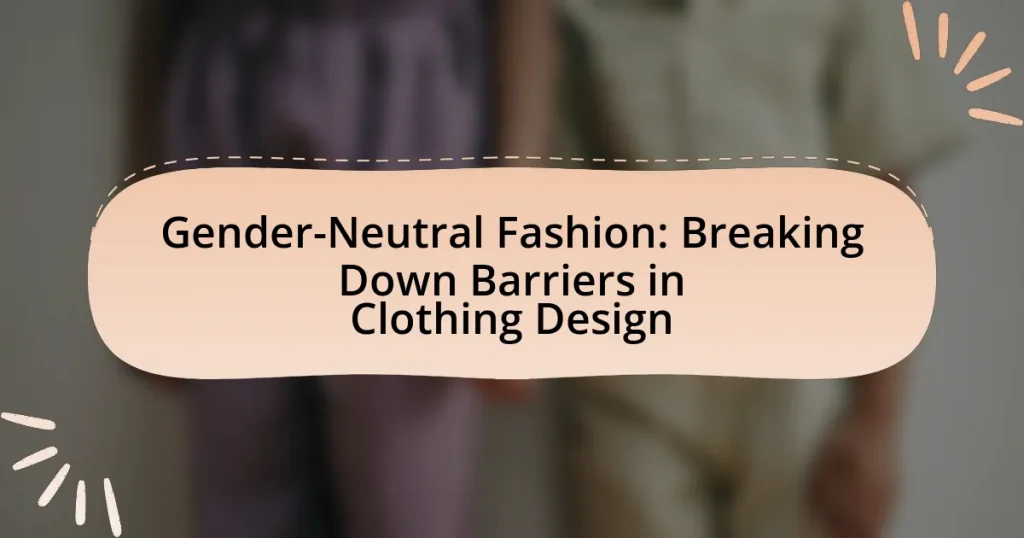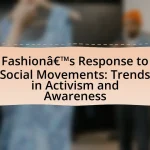Gender-neutral fashion is a clothing movement designed to be inclusive of all gender identities, challenging traditional gender norms by offering unisex styles and versatile silhouettes. This article explores the key characteristics of gender-neutral fashion, its importance in promoting inclusivity, and the historical and cultural factors that have influenced its rise. It also examines the barriers that gender-neutral fashion seeks to dismantle, the role of fashion icons in its promotion, and the current trends and challenges faced by designers. Additionally, the article highlights how individuals can incorporate gender-neutral pieces into their wardrobes and provides resources for exploring this evolving fashion landscape.
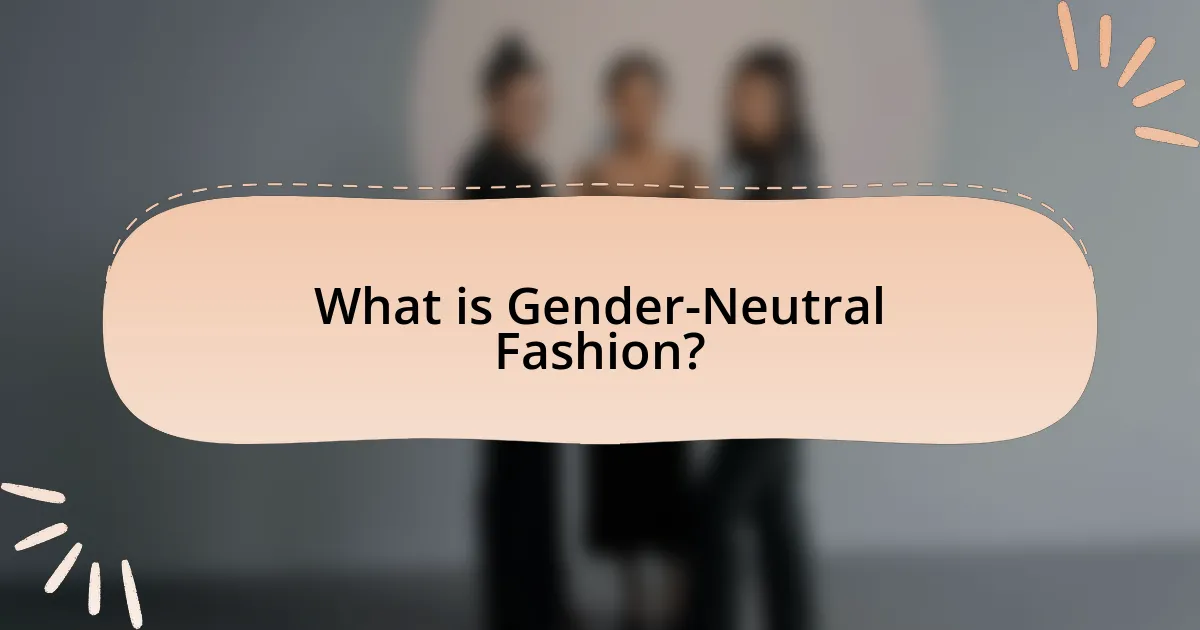
What is Gender-Neutral Fashion?
Gender-neutral fashion refers to clothing designed to be worn by individuals regardless of their gender identity, promoting inclusivity and breaking traditional gender norms in fashion. This approach often features unisex styles, silhouettes, and colors that do not conform to conventional male or female categories. The rise of gender-neutral fashion is supported by cultural shifts towards acceptance of diverse gender identities, with brands increasingly adopting inclusive practices to cater to a broader audience.
How does Gender-Neutral Fashion differ from traditional fashion?
Gender-neutral fashion differs from traditional fashion primarily in its rejection of gender-specific clothing categories. Traditional fashion typically adheres to binary gender norms, offering distinct styles and fits for men and women, while gender-neutral fashion promotes inclusivity by designing garments that can be worn by anyone, regardless of gender identity. This approach is supported by a growing cultural shift towards acceptance of diverse gender expressions, as evidenced by the increasing number of brands, such as Telfar and Rad Hourani, that focus on unisex designs. Additionally, gender-neutral fashion often emphasizes comfort and versatility, prioritizing functionality over traditional gendered aesthetics, which aligns with contemporary consumer preferences for more adaptable and expressive clothing options.
What are the key characteristics of Gender-Neutral Fashion?
Gender-neutral fashion is characterized by inclusivity, versatility, and a rejection of traditional gender norms in clothing design. This fashion approach emphasizes unisex silhouettes, neutral color palettes, and adaptable styles that can be worn by individuals regardless of their gender identity. For instance, many brands now offer clothing that features relaxed fits and minimalistic designs, allowing for greater freedom of expression. The rise of gender-neutral fashion is supported by cultural shifts towards acceptance and representation, as seen in the increasing visibility of non-binary and gender-fluid individuals in media and fashion.
Why is Gender-Neutral Fashion important in today’s society?
Gender-neutral fashion is important in today’s society because it promotes inclusivity and challenges traditional gender norms. This fashion movement allows individuals to express their identity without being confined to binary gender categories, fostering a sense of belonging for diverse gender identities. Research indicates that 62% of Gen Z consumers prefer brands that offer gender-neutral options, reflecting a significant cultural shift towards acceptance and representation in fashion. By breaking down barriers in clothing design, gender-neutral fashion not only enhances personal expression but also contributes to a broader societal understanding of gender fluidity.
What historical factors have influenced Gender-Neutral Fashion?
Historical factors influencing gender-neutral fashion include the feminist movement, the rise of androgyny in the 20th century, and cultural shifts towards inclusivity. The feminist movement of the 1960s and 1970s challenged traditional gender roles, promoting clothing that defied binary norms. The 1980s and 1990s saw androgynous styles popularized by musicians and fashion icons, further blurring gender lines. Additionally, societal changes towards acceptance of identities have fostered a demand for clothing that transcends gender, leading to the emergence of brands focused on gender-neutral designs. These historical contexts demonstrate how social movements and cultural trends have shaped the evolution of gender-neutral fashion.
How have cultural shifts impacted clothing design?
Cultural shifts have significantly impacted clothing design by promoting inclusivity and challenging traditional gender norms. The rise of gender-neutral fashion reflects a broader societal acceptance of diverse identities, leading designers to create collections that prioritize comfort and versatility over rigid gender classifications. For instance, brands like Telfar and Rad Hourani have gained recognition for their unisex designs, which cater to a wide audience and emphasize personal expression. This shift is supported by research indicating that 56% of Gen Z consumers prefer brands that offer gender-neutral options, highlighting a demand for clothing that transcends conventional gender boundaries.
What role have fashion icons played in promoting Gender-Neutral Fashion?
Fashion icons have significantly influenced the promotion of gender-neutral fashion by challenging traditional gender norms and showcasing inclusive styles. Through their visibility and platform, these icons, such as Harry Styles and Jaden Smith, have embraced clothing that defies gender binaries, encouraging broader acceptance of gender fluidity in fashion. Their public appearances in gender-neutral attire have sparked conversations and inspired both designers and consumers to explore and adopt more inclusive fashion choices, thereby contributing to a cultural shift towards acceptance and diversity in clothing design.
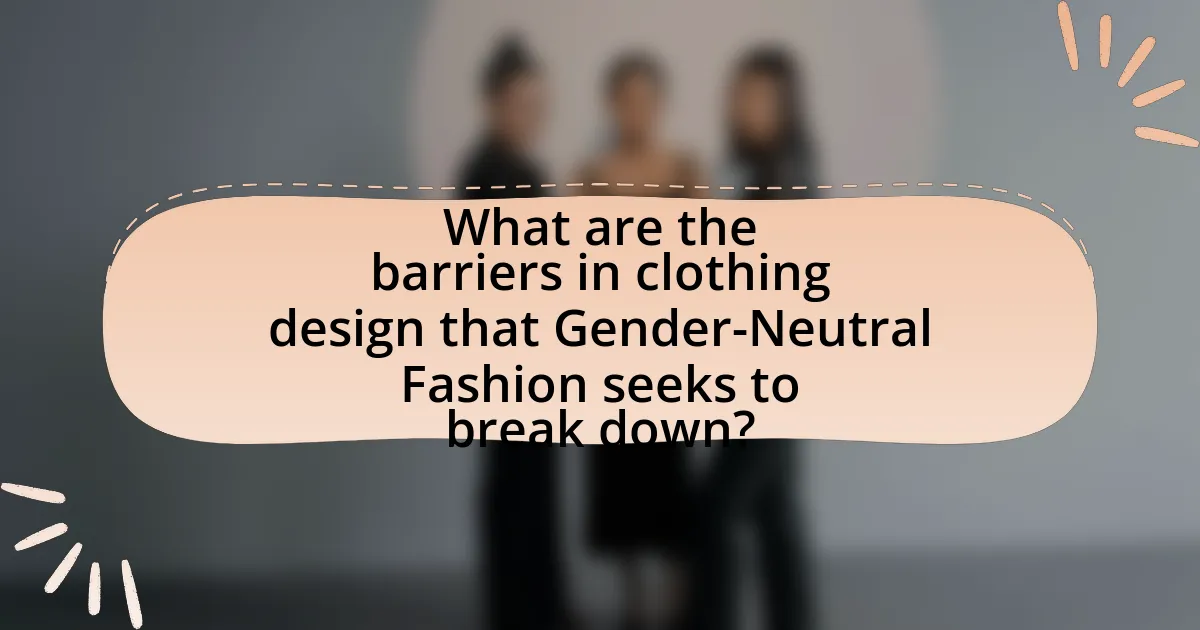
What are the barriers in clothing design that Gender-Neutral Fashion seeks to break down?
Gender-Neutral Fashion seeks to break down barriers such as rigid gender norms, limited sizing options, and the binary classification of clothing. These barriers restrict individuals from expressing their identity and preferences freely. For instance, traditional clothing design often enforces a strict division between men’s and women’s apparel, which can alienate those who do not conform to these categories. Additionally, the lack of inclusive sizing can marginalize individuals who fall outside conventional size ranges, further limiting their choices. By promoting designs that are accessible and adaptable for all genders, Gender-Neutral Fashion aims to create a more inclusive and diverse clothing landscape.
How do societal norms affect clothing choices?
Societal norms significantly influence clothing choices by dictating what is considered acceptable or appropriate attire for different genders and social contexts. These norms shape individual preferences and behaviors, often leading people to conform to established standards of dress that align with cultural expectations. For instance, traditional gender roles have historically assigned specific clothing styles to men and women, such as suits for men and dresses for women, which can limit personal expression and reinforce stereotypes. Research indicates that adherence to these norms can affect self-esteem and social acceptance, as individuals may feel pressured to dress in ways that align with societal expectations to avoid judgment or ostracism.
What stereotypes are challenged by Gender-Neutral Fashion?
Gender-neutral fashion challenges the stereotypes of traditional gender roles in clothing, specifically the notion that certain styles, colors, and fits are exclusively for men or women. This fashion movement promotes inclusivity by allowing individuals to express their identity without being confined to societal expectations. For instance, the rise of unisex clothing lines demonstrates a shift away from binary classifications, as brands like Telfar and Rad Hourani create designs that appeal to all genders. This approach not only broadens the market but also encourages a more fluid understanding of gender identity, reflecting contemporary societal changes.
How does Gender-Neutral Fashion promote inclusivity?
Gender-neutral fashion promotes inclusivity by eliminating traditional gender norms in clothing, allowing individuals to express their identity without restriction. This approach fosters a sense of belonging for people of all gender identities, as it provides options that are not confined to male or female categories. Research indicates that 62% of consumers prefer brands that offer gender-neutral options, highlighting a growing demand for inclusivity in fashion. By prioritizing comfort and personal expression over gender conformity, gender-neutral fashion creates a more welcoming environment for everyone, regardless of their gender identity.
What challenges do designers face in creating Gender-Neutral Fashion?
Designers face several challenges in creating gender-neutral fashion, primarily stemming from societal norms and market expectations. Traditional gender norms dictate specific styles and fits for men and women, making it difficult for designers to develop collections that appeal to a broad audience without alienating specific demographics. Additionally, there is a lack of established sizing standards for gender-neutral clothing, which complicates the design process and can lead to consumer confusion. Market demand also poses a challenge; many consumers still prefer gender-specific clothing, which can limit the commercial viability of gender-neutral lines. Furthermore, designers often encounter resistance from retailers who may be hesitant to stock gender-neutral items due to perceived risks in sales performance. These factors collectively hinder the advancement of gender-neutral fashion in a market that is still heavily influenced by traditional gender binaries.
How can designers balance aesthetics and functionality in Gender-Neutral designs?
Designers can balance aesthetics and functionality in gender-neutral designs by prioritizing versatile silhouettes and materials that appeal to a broad audience while ensuring comfort and practicality. For instance, using unstructured shapes and neutral color palettes allows for visual appeal without adhering to traditional gender norms. Additionally, incorporating features like adjustable sizing and multi-functional elements enhances usability, making the designs more accessible. Research indicates that consumers increasingly prefer clothing that combines style with comfort, as seen in a 2021 survey by McKinsey & Company, which found that 67% of respondents value comfort in their clothing choices. This evidence supports the notion that a focus on both aesthetics and functionality can lead to successful gender-neutral designs.
What are the common misconceptions about Gender-Neutral Fashion?
Common misconceptions about gender-neutral fashion include the belief that it is solely unisex clothing, that it lacks style, and that it is only for non-binary individuals. Gender-neutral fashion encompasses a broader spectrum of designs that challenge traditional gender norms, offering diverse styles that appeal to all genders. Research indicates that the market for gender-neutral clothing is expanding, with brands like Telfar and Rad Hourani gaining popularity for their inclusive designs, demonstrating that gender-neutral fashion can be both stylish and versatile.
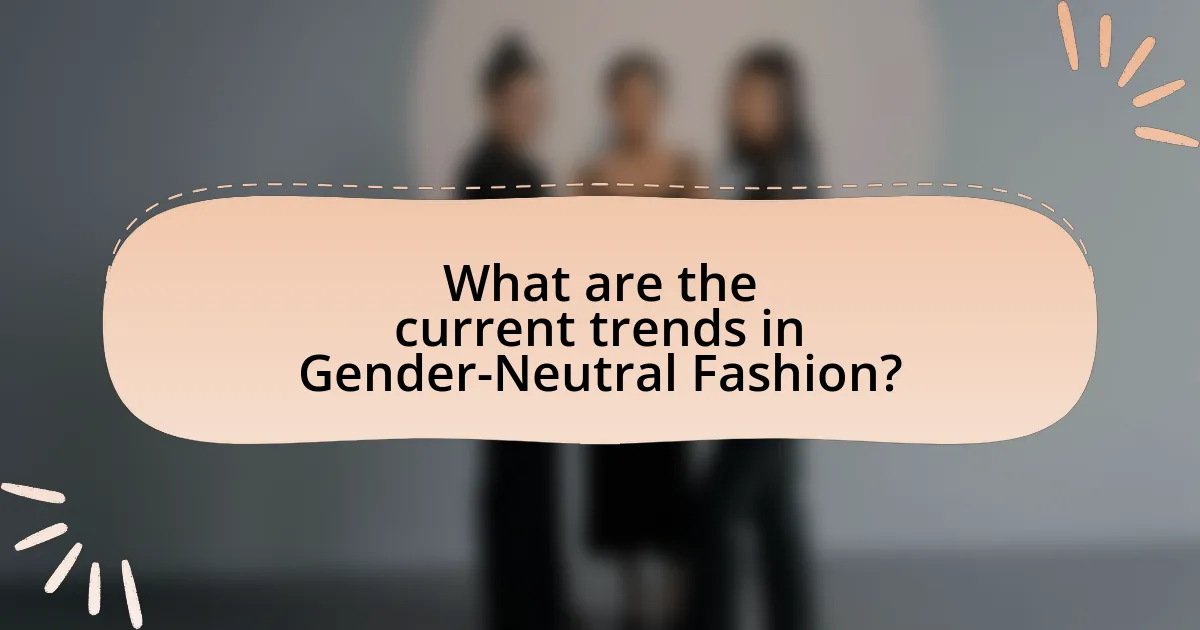
What are the current trends in Gender-Neutral Fashion?
Current trends in gender-neutral fashion include oversized silhouettes, unisex designs, and the use of neutral color palettes. Designers are increasingly creating collections that prioritize comfort and versatility, appealing to a broader audience regardless of gender. For instance, brands like Telfar and Rad Hourani have gained recognition for their inclusive approach, showcasing garments that can be worn by anyone. Additionally, the rise of sustainable materials and ethical production practices is becoming prominent, reflecting a growing consumer demand for responsible fashion choices. This shift is supported by market research indicating that 62% of Gen Z consumers prefer brands that promote inclusivity and diversity in their offerings.
How are brands adapting to the Gender-Neutral Fashion movement?
Brands are adapting to the Gender-Neutral Fashion movement by creating unisex collections that prioritize inclusivity and versatility. Major fashion labels like Gucci and Zara have launched lines that feature gender-neutral designs, allowing consumers to choose clothing based on personal style rather than gender norms. Additionally, brands are utilizing diverse models in their marketing campaigns to reflect a broader spectrum of gender identities, which enhances relatability and acceptance. This shift is supported by market research indicating that 73% of Gen Z consumers prefer brands that promote inclusivity, demonstrating a clear demand for gender-neutral options in the fashion industry.
What innovative materials are being used in Gender-Neutral clothing?
Innovative materials used in gender-neutral clothing include organic cotton, recycled polyester, and Tencel. Organic cotton is favored for its sustainability and softness, making it suitable for diverse body types. Recycled polyester, derived from plastic bottles, reduces waste and offers durability, while Tencel, made from sustainably sourced wood pulp, provides breathability and a luxurious feel. These materials align with the growing demand for eco-friendly and versatile fashion, catering to a wide range of consumers regardless of gender.
How are marketing strategies evolving for Gender-Neutral Fashion?
Marketing strategies for gender-neutral fashion are evolving to emphasize inclusivity and diversity, targeting a broader audience beyond traditional gender norms. Brands are increasingly utilizing social media platforms to engage with consumers, showcasing diverse models and promoting unisex collections that challenge conventional gendered marketing. For instance, companies like Telfar and Wildfang have successfully leveraged campaigns that highlight the fluidity of gender, resulting in increased brand loyalty and sales. This shift is supported by research indicating that 62% of consumers prefer brands that reflect their values, including inclusivity in fashion.
What role does sustainability play in Gender-Neutral Fashion?
Sustainability plays a crucial role in gender-neutral fashion by promoting environmentally friendly practices and reducing waste in the clothing industry. Gender-neutral fashion often emphasizes timeless designs and versatile pieces, which can lead to longer product lifespans and less frequent purchases. This approach aligns with sustainable principles, as it encourages consumers to invest in quality over quantity. Additionally, many brands in this space utilize sustainable materials, such as organic cotton or recycled fabrics, which further minimizes environmental impact. For instance, a report by the Ellen MacArthur Foundation highlights that the fashion industry could reduce its carbon emissions by 1.1 billion tons annually by adopting circular economy practices, which are often embraced by gender-neutral fashion brands.
How can sustainable practices enhance Gender-Neutral clothing lines?
Sustainable practices can enhance gender-neutral clothing lines by promoting inclusivity and reducing environmental impact. By utilizing eco-friendly materials and ethical production methods, brands can create versatile designs that appeal to a broader audience, regardless of gender. For instance, the use of organic cotton and recycled fabrics not only minimizes waste but also aligns with the values of consumers who prioritize sustainability. Research indicates that 66% of consumers are willing to pay more for sustainable brands, demonstrating a market demand for environmentally conscious gender-neutral options. This approach not only fosters a more inclusive fashion landscape but also addresses the growing concern for sustainability in the industry.
What are the environmental impacts of traditional versus Gender-Neutral Fashion?
Traditional fashion typically has a higher environmental impact compared to gender-neutral fashion due to its reliance on fast fashion practices, which contribute to significant waste and pollution. Traditional clothing often involves the use of synthetic materials, which are derived from fossil fuels and can take hundreds of years to decompose, leading to increased landfill waste. In contrast, gender-neutral fashion often emphasizes sustainable materials and production methods, reducing the carbon footprint associated with clothing manufacturing. For instance, a study by the Ellen MacArthur Foundation highlights that the fashion industry is responsible for 10% of global carbon emissions, with fast fashion being a major contributor. Gender-neutral brands are increasingly adopting eco-friendly practices, such as using organic cotton and recycled materials, which mitigate environmental harm.
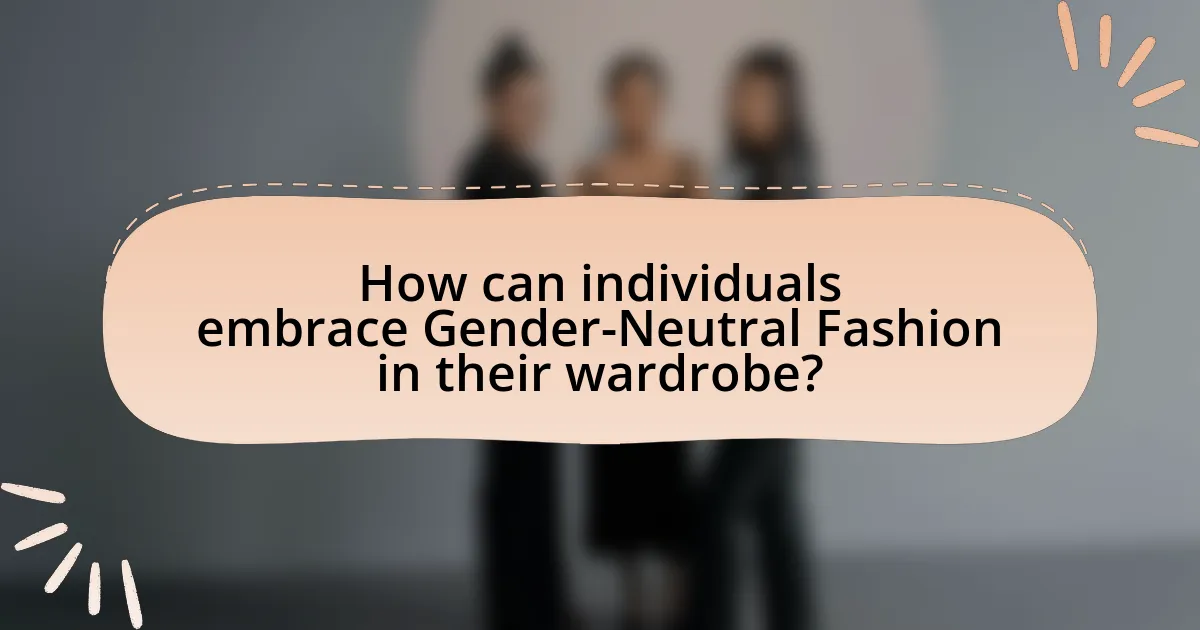
How can individuals embrace Gender-Neutral Fashion in their wardrobe?
Individuals can embrace gender-neutral fashion in their wardrobe by selecting versatile clothing items that do not conform to traditional gender norms. This includes opting for unisex styles, such as oversized shirts, tailored trousers, and neutral-toned outerwear, which can be worn by anyone regardless of gender identity. Research indicates that the rise of gender-neutral fashion reflects a broader societal shift towards inclusivity, with brands like Telfar and Rad Hourani leading the way in offering collections that prioritize comfort and self-expression over gendered expectations. By incorporating these styles, individuals can create a wardrobe that celebrates diversity and personal identity.
What tips can help individuals incorporate Gender-Neutral pieces into their style?
To incorporate gender-neutral pieces into their style, individuals should focus on selecting versatile clothing items that can be worn by anyone, regardless of gender. This includes choosing oversized silhouettes, unisex cuts, and neutral color palettes that promote inclusivity. For example, brands like Telfar and Rad Hourani offer collections designed specifically with gender neutrality in mind, showcasing how such pieces can be both fashionable and functional. Additionally, layering can enhance the adaptability of outfits, allowing individuals to mix and match gender-neutral items with their existing wardrobe. By prioritizing comfort and personal expression over traditional gender norms, individuals can create a unique style that reflects their identity while embracing gender-neutral fashion.
How can one mix and match Gender-Neutral clothing effectively?
To mix and match gender-neutral clothing effectively, one should focus on versatile pieces that can be styled in multiple ways. Selecting items like oversized shirts, tailored trousers, and unisex outerwear allows for a range of combinations that suit various occasions. For instance, pairing a loose-fitting button-up shirt with straight-leg jeans creates a balanced look that is both comfortable and stylish. Additionally, incorporating neutral colors and simple patterns enhances the ability to mix and match, as these elements tend to coordinate well with a variety of other garments. Research indicates that gender-neutral fashion promotes inclusivity and self-expression, making it a significant trend in contemporary clothing design.
What are some essential Gender-Neutral wardrobe staples?
Essential gender-neutral wardrobe staples include oversized t-shirts, tailored trousers, denim jackets, and versatile sneakers. These items are designed to fit a variety of body types and can be styled in multiple ways, making them suitable for anyone regardless of gender. For instance, oversized t-shirts provide comfort and can be paired with different bottoms, while tailored trousers offer a polished look that works for both casual and formal settings. Denim jackets are timeless and can layer over various outfits, and versatile sneakers serve as a practical footwear option that complements diverse styles. These staples reflect the growing trend towards inclusivity in fashion, allowing individuals to express themselves without the constraints of traditional gender norms.
What resources are available for exploring Gender-Neutral Fashion?
Resources for exploring gender-neutral fashion include online platforms, books, and academic journals. Websites like GenderFreeWorld and The Phluid Project offer curated collections and insights into gender-neutral clothing. Books such as “The Gendered Society” by Michael Kimmel and “Gender Neutral: A Fashion Revolution” by J. M. H. provide theoretical frameworks and case studies. Academic journals like Fashion Theory and the Journal of Gender Studies publish research articles that analyze trends and cultural implications of gender-neutral fashion. These resources collectively provide a comprehensive understanding of the evolving landscape of gender-neutral clothing design.
Where can individuals find Gender-Neutral brands and designers?
Individuals can find Gender-Neutral brands and designers through various online platforms and retail stores that specialize in inclusive fashion. Notable examples include websites like ASOS, which features a dedicated section for gender-neutral clothing, and brands such as Telfar and Wildfang, known for their unisex collections. Additionally, marketplaces like Etsy offer a range of independent designers who create gender-neutral apparel. These platforms and brands are recognized for their commitment to breaking traditional gender norms in fashion, making them reliable sources for individuals seeking gender-neutral options.
What online communities support Gender-Neutral Fashion enthusiasts?
Online communities that support Gender-Neutral Fashion enthusiasts include platforms like Reddit, specifically the r/genderneutral subreddit, which fosters discussions and sharing of gender-neutral fashion ideas. Additionally, Facebook groups such as “Gender Neutral Fashion” provide a space for members to exchange tips, styles, and resources. Instagram also serves as a community hub where hashtags like #GenderNeutralFashion connect users and showcase diverse fashion choices. These platforms collectively create an inclusive environment for individuals interested in gender-neutral fashion, facilitating interaction and inspiration among enthusiasts.
